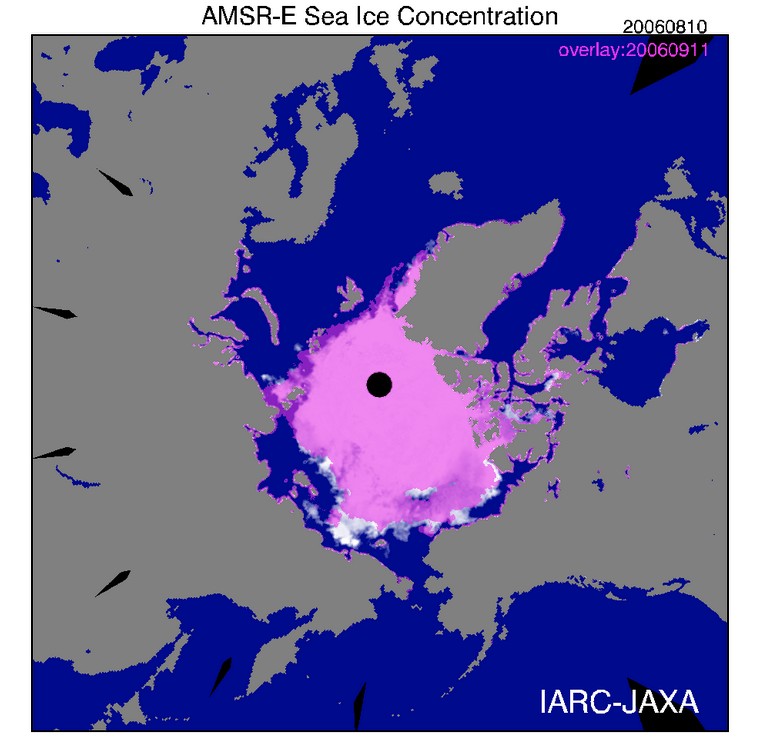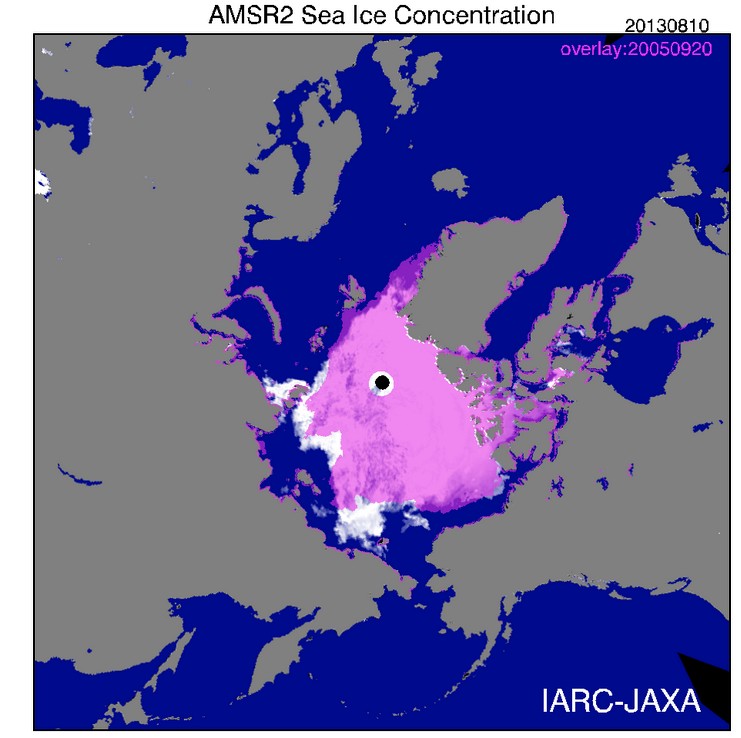Arctic ice extent is currently in second place behind 2006.
COI | Centre for Ocean and Ice | Danmarks Meteorologiske Institut
The next map compares current ice (white) vs. the 2006 minimum (pink.) Unless a very early freeze starts, it seems unlikely that 2013 will beat 2006.
The next map does the same comparison vs. 2005. It is quite possible that 2013 will beat 2005, if temperatures remain cold.





New Asian coal plants blacken the Arctic but an intense circle of wind isolates Antarctica, seen clearly here:
http://www.goes-r.gov/users/comet/tropical/textbook_2nd_edition/navmenu.php_tab_4_page_2.3.0.htm
the problem with these charts is that the Arctic being a closed ocean, some Seas go from zero percent to 100 percent and back during the course of a year, so they can’t tell us much about “change” (you cannot have less than zero or more than 100%).
I suspect that’s what makes the spaghettis so tight next to each other every year for most of the time.
I also am not sure if Polar sea ice outside of the Ocean is counted in, as in the Baltic.
Indeed omnologos, there were many good blogs at WUWT and other sites on the nonsense of the sea ice “climate science” but the alarmists made it and the polar bears poster boys for GLO-BULL warming and now we can only play the hand they dealt.
The game may be called shortly on account of too much sea ice on the field!!
Completely rubbish post in my opinion,
What are you actually agreeing with apart from wanting to say “Pitchfork and burn them all ” ?
I’ll try and answer on your behalf.
Andy
Firstly it is not a closed ocean but you are correct in saying land masses play a part on the ice extent. In winter the ice extent is hemmed in, in summer it is not hemmed in so that is more susceptible to conditions. Hence why you get big summer differences recently.
You said
” so they can’t tell us much about “change” (you cannot have less than zero or more than 100%)”
But they do not all go to zero or 100%. It is the seas that are not doing that but are decreasing that are of interest.
Andy
Just scanning by eye, this year’s ice doesn’t quite match up in the two pictures. (I apologize for lacking the skill to do the correction, and sounding like a nag.)
What has been interesting this year is the lack of ice off the east coast of Greenland, which shows the ice isn’t flushing out through Fram Strait like it did in 2005, and especially 2007. However the current big storm at the pole seems to be moving ice a bit towards Fram Strait: http://sunriseswansong.wordpress.com/2013/08/06/north-pole-camera-one-pictures-polar-bear-tracks/ (Update at bottom.) Much other ice is just spinning around the pole like a top.
However the thing the storm makes me wonder about is: How much heat is being used up by thermal lift in the storm, and how much cold air (and snow) is being brought down to the surface? Perhaps a more qualified meteorologist could venture an opinion. As a layman, I think a storm positioned right at the pole like this one might bring about an early start to freezing, but then I wonder if it might suck warm air north. The next week will make for interesting watching.
The MYI was pushed over Canada last and this may have been part of the cause of the good ice extent this year, as a kind of positive feed back, because the winds are now more favorable than in 2012.